 W
WBerg wind is the South African name for a katabatic wind: a hot dry wind blowing down the Great Escarpment from the high central plateau to the coast.
 W
WBergie is a term used for a subsection of homeless people in Cape Town, South Africa. The word originates from the Afrikaans berg meaning "mountain" – the term originally referred to the homeless people who sheltered in the forests of the slopes of Table Mountain. The synonymous term stroller typically refers to street children living a bergie lifestyle.
 W
WBiltong is a form of dried, cured meat that originated in Southern African countries. Various types of meat are used to produce it, ranging from beef to game meats such as ostrich or kudu. The cut may also vary, either fillets of meat cut into strips following the grain of the muscle, or flat pieces sliced across the grain. It is related to beef jerky in that they are both spiced, dried meats; however, the typical ingredients, taste and production processes may differ.
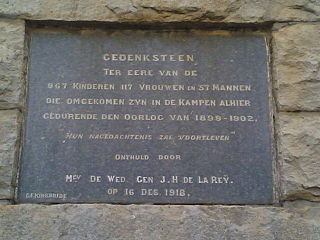 W
WThe Bittereinders or irreconcilables were a faction of Boer guerrilla fighters, resisting the forces of the British Empire in the later stages of the Second Boer War (1899–1902).
 W
WThe Boerboel [ˈbuːrbul], is a large, mastiff-type dog from South Africa with a black mask and a short coat. This dog breed is large with a strong bone structure and well developed muscles. Its head appears blocky with a short length between the stop and nose. It carries itself with a confident and powerful movement, is fearless and shows courage when threatened.
 W
WBoerewors, a type of sausage which originated in South Africa, is an important part of South African and Namibian cuisine and is popular across Southern Africa. The name is derived from the Afrikaans/Dutch words boer ("farmer") and wors ("sausage"). According to South African government regulation boerewors must contain at least 90 percent meat, and always contain beef, as well as lamb, pork, or a mixture of lamb and pork. The other 10% is made up of spices and other ingredients. Not more than 30% of the meat content may be fat. Boerewors may not contain offal or any "mechanically recovered" meat pulp.
 W
WThe Boerperd is a modern breed of horse from South Africa. It is a re-creation of the traditional Cape Horse or old-type Boer Horse, which is now extinct.
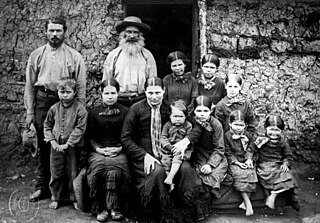 W
WBoers refers to the descendants of the proto-Afrikaans-speaking colonists of the eastern Cape frontier in Southern Africa during the 18th and much of the 19th century. From 1652 to 1795, the Dutch East India Company controlled this area, but the United Kingdom incorporated it into the British Empire in 1806. The name of the group is derived from the Dutch and Afrikaans word for farmer.
 W
WThe bontebok is a subspecies of Damaliscus pygargus, an antelope found in South Africa, Lesotho and Namibia. D. pygargus has two subspecies; the bontebok, occurring naturally in the Fynbos and Renosterveld areas of the Western Cape, and the blesbok occurring in the Highveld.
 W
WThe boomslang is a large, highly venomous snake in the family Colubridae.
 W
WBarbecue varies by the type of meat, sauce, rub, or other flavorings used, the point in barbecuing at which they are added, the role smoke plays, the equipment and fuel used, cooking temperature, and cooking time.
 W
WBarbecue varies by the type of meat, sauce, rub, or other flavorings used, the point in barbecuing at which they are added, the role smoke plays, the equipment and fuel used, cooking temperature, and cooking time.
 W
WDroëwors is a Southern African snack food, based on the traditional, coriander-seed spiced boerewors sausage. It is usually made as a dunwors rather than dikwors, as the thinner sausage dries quicker and is thus, less likely to spoil before it can be preserved. If dikwors is to be used, it is usually flattened to provide a larger surface area for drying.
 W
WA duiker is a small to medium-sized brown antelope native to sub-Saharan Africa, found in heavily wooded areas. The 22 extant species, including three sometimes considered to be subspecies of the other species, form the subfamily Cephalophinae.
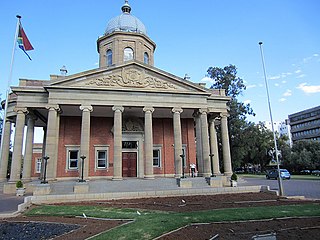 W
WThe Fourth Raadsaal is a historic building in Bloemfontein, South Africa, which serves as the meeting place of the Free State Provincial Legislature, the legislature of the Free State. It is located opposite the Supreme Court of Appeal in President Brand Street.
 W
WThe Genootskap van Regte Afrikaners was formed on 14 August 1875 in the town of Paarl by a group of Afrikaans speakers from the current Western Cape region. From 15 January 1876 the society published a journal in Afrikaans called Die Afrikaanse Patriot as well as a number of books, including grammars, dictionaries, religious material and histories. Die Afrikaanse Patriot was succeeded in 1905 by today's Paarl newspaper.
 W
WThe klipspringer is a small antelope found in eastern and southern Africa. The sole member of its genus, the klipspringer was first described by German zoologist Eberhard August Wilhelm von Zimmermann in 1783. The klipspringer is a small, sturdy antelope; it reaches 43–60 centimetres at the shoulder and weighs from 8 to 18 kilograms. The coat of the klipspringer, yellowish gray to reddish brown, acts as an efficient camouflage in its rocky habitat. Unlike most other antelopes, the klipspringer has a thick and coarse coat with hollow, brittle hairs. The horns, short and spiky, typically measure 7.5–9 cm.
 W
WKloof is a leafy upper-class suburb, that includes a smaller area called Everton, in the greater Durban area of eThekwini in KwaZulu-Natal, South Africa.
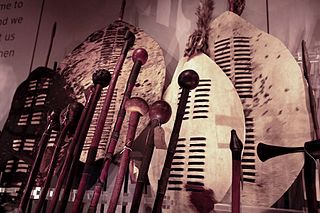 W
WA knobkerrie, also spelled knobkerry, knobkierie, and knopkierie (Afrikaans), is a form of club used mainly in Southern and Eastern Africa. Typically they have a large knob at one end and can be used for throwing at animals in hunting or for clubbing an enemy's head.
 W
WA koeksister is a traditional Afrikaner confectionery made of fried dough infused in syrup or honey. It should not be confused with the similar sounding Cape Malay koe'sister, which is a fried ball of dough that's rolled in desiccated coconut. The name derives from the Dutch word "koek", which generally means a wheat flour confectionery, also the origin of the American English word "cookie", and "sister" can refer to the oral tradition of two sisters plaiting their doughnuts and then dunking them in syrup, so creating this iconic pastry. "Sis" can also refer to the sizzling sound
 W
WKraal is an Afrikaans and Dutch word, also used in South African English, for an enclosure for cattle or other livestock, located within a Southern African settlement or village surrounded by a fence of thorn-bush branches, a palisade, mud wall, or other fencing, roughly circular in form. It is similar to a boma in eastern or central Africa.
 W
WThe Reformed Churches in South Africa is a Christian denomination in South Africa that was formed in 1859 in Rustenburg. Members of the church are sometimes referred to as Doppers.
 W
WThe rinkhals, also called the ringhals or ring-necked spitting cobra, is a species of venomous elapid found in parts of southern Africa. It is not a true cobra in that it does not belong to the genus Naja, but instead belongs to the monotypic genus Hemachatus. While rinkhals bear a great resemblance to true cobras they also possess some remarkable differences from these, resulting in their placement outside the genus Naja.
 W
WAn African-style hut known in literature as cone on cylinder or cone on drum, but popularly referred to simply as rondavel. It has largely undergone Westernization in its recent developments, but it also remains the popular perception of a traditional indigenous settlement.
 W
WRooibos, meaning "red bush"; is a broom-like member of the plant family Fabaceae that grows in South Africa's fynbos.
 W
WThe sjambok or litupa is a heavy leather whip. It is traditionally made from an adult hippopotamus or rhinoceros hide, but is also commonly made out of plastic.
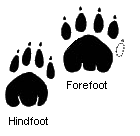 W
WSpoor is a trace or a set of footprints by which the progress of someone or something may be followed. Spoor may include tracks, scents, or broken foliage. Spoor is useful for discovering or surveying what types of animals live in an area, or in animal tracking.
 W
WThe Trekboers were nomadic pastoralists descended from European settlers on the frontiers of the Dutch Cape Colony in Southern Africa. The Trekboers began migrating into the interior from the areas surrounding what is now Cape Town, such as Paarl, Stellenbosch, and Franschhoek, during the late 17th century and throughout the 18th century. The Trekboer included mixed-race families of partial Khoikoi descent that had also become established within the economic class of burghers.
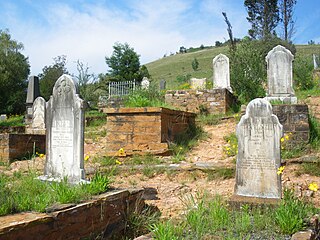 W
WUitlander, Afrikaans for "foreigner", was a foreign migrant worker during the Witwatersrand Gold Rush in the independent Transvaal Republic following the discovery of gold in 1886. The limited rights granted this group in the independent Boer Republics was one of the contributing factors behind the Second Boer War.
 W
WVeld, also spelled veldt, is a type of wide open rural landscape in Southern Africa. Particularly, it is a flat area covered in grass or low scrub, especially in the countries of South Africa, Lesotho, Eswatini, Zimbabwe and Botswana. A certain sub-tropical woodland ecoregion of Southern Africa has been officially defined as the Bushveld by the World Wide Fund for Nature. Trees are found only in a few places—frost, fire and grazing animals allow grass to grow but prevent the growth of trees.
 W
WVeldskoene ("FELT-skoona") or colloquially vellies ("FELL-ys"), are Southern African walking shoes made from vegetable-tanned leather or soft rawhide uppers attached to a leather footbed and rubber sole without tacks or nails.
 W
WA vlei is a shallow minor lake, mostly of a seasonal or intermittent nature. It even might refer to seasonal ponds or marshy patches where frogs and similar marsh dwellers breed. Commonly, vleis vary in their extent, or even in the presence or absence of water, according to the fall of rain or dryness of the season. In terms of water salinity, vleis may be freshwater, saltwater, or brackish. Over time a vlei may degrade into a salt pan or clay pan, such as Dead Vlei or Sossusvlei.
 W
WVolkspele is a South African folk dance tradition.
 W
WThe Volksraad was the parliament of the former South African Republic (ZAR), it existed from 1840 to 1877, and from 1881 to 1902 in part of what is now South Africa. The body ceased to exist after the British Empire's victory in the Second Anglo-Boer War. The Volksraad sat in session in Ou Raadsaal in Church Square, Pretoria.
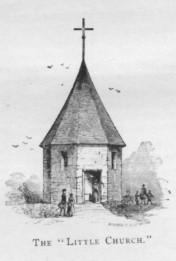 W
WVoorleser was the title given to a highly responsible citizen in New Netherland and later Dutch colonies, who had semi-official duties in local law, education and religion.
 W
WThe Great Trek, starting in 1836 in southern Africa, was a mass migration of Dutch-speaking inhabitants of the British-run Cape Colony, who left the Cape and travelled eastward by wagon train, into the interior of the continent, in order to live beyond the reach of the British colonial administration. Both the Cape Colony and the area newly colonised by the migrants later became part of what is today the country of South Africa. The Great Trek was spurred by rising tensions between rural descendants of the Cape's original, mostly Dutch, European colonists, known collectively as Boers, and the later, mostly British, colonists, who had taken control of the Cape on behalf of the British Empire. It was also spurred by an increasing yearning among members of the various Boer communities to live in a more isolationist, semi-nomadic way than had become possible in Cape Town, which was becoming much more administratively complex under British management. Boers who took part in the Great Trek identified themselves as voortrekkers, meaning pioneers or pathfinders in Dutch and Afrikaans.
 W
WZef is a South African counter-culture movement. Kyle Hans Brockmann has compared zef counter-culture to many similar anarchic sub-cultures in the northern hemisphere.